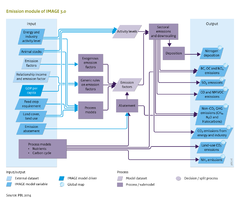Emissions/Policy issues: Difference between revisions
Jump to navigation
Jump to search
Oostenrijr (talk | contribs) m (Text replace - "N2O" to "N<sub>2</sub>O") |
Oostenrijr (talk | contribs) m (Text replace - "NOx" to "NO<sub>x</sub>") |
||
| Line 5: | Line 5: | ||
* Introduction of climate policy, which leads to systemic changes in the energy system (less combustion) and thus, indirectly to reduced emissions of air pollutants ([[Van Vuuren et al., 2006]]). | * Introduction of climate policy, which leads to systemic changes in the energy system (less combustion) and thus, indirectly to reduced emissions of air pollutants ([[Van Vuuren et al., 2006]]). | ||
* Policy interventions can be mimicked by introducing an alternative formulation of emission factors to the standard formulations ({{abbrTemplate|EKC}}, {{abbrTemplate|CLE}}). For instance, emission factors can be used to deliberately include maximum feasible reduction measures. | * Policy interventions can be mimicked by introducing an alternative formulation of emission factors to the standard formulations ({{abbrTemplate|EKC}}, {{abbrTemplate|CLE}}). For instance, emission factors can be used to deliberately include maximum feasible reduction measures. | ||
* Policies may influence emission levels for several sources, for instance, by reducing consumption of meat products. By improving the efficiency of fertiliser use, emissions of N<sub>2</sub>O, NO and NH3 can be decreased ([[Van Vuuren et al., 2011b]]). By increasing the amount of feed crops in the cattle rations, CH<sub>4</sub> emissions can be reduced. Production of crop types has a significant influence on emission levels of N<sub>2</sub>O, | * Policies may influence emission levels for several sources, for instance, by reducing consumption of meat products. By improving the efficiency of fertiliser use, emissions of N<sub>2</sub>O, NO and NH3 can be decreased ([[Van Vuuren et al., 2011b]]). By increasing the amount of feed crops in the cattle rations, CH<sub>4</sub> emissions can be reduced. Production of crop types has a significant influence on emission levels of N<sub>2</sub>O, NO<sub>x</sub> and NH3 from spreading manure and fertilisers. | ||
* Assumptions related to soil and nutrient management. The major factors are fertiliser type and mode of manure and fertiliser application. Some fertilisers cause higher emissions of N<sub>2</sub>O and NH3 than others. Incorporating manure into soil lowers emissions compared to broadcasting. | * Assumptions related to soil and nutrient management. The major factors are fertiliser type and mode of manure and fertiliser application. Some fertilisers cause higher emissions of N<sub>2</sub>O and NH3 than others. Incorporating manure into soil lowers emissions compared to broadcasting. | ||
The impacts of more ambitious control policies ({{abbrTemplate|CLE}} versus {{abbrTemplate|EKC}}) on SO<sub>2</sub> and | The impacts of more ambitious control policies ({{abbrTemplate|CLE}} versus {{abbrTemplate|EKC}}) on SO<sub>2</sub> and NO<sub>x</sub>, emissions, and the influence of climate policy are presented in the figure below. Where climate policy is particularly effective in reducing SO<sub>2</sub> emissions, air pollution control policies are effective in reducing NO<sub>x</sub> emissions. | ||
See also the Policy interventions Table below. | See also the Policy interventions Table below. | ||
}} | }} | ||
Revision as of 10:38, 1 July 2014
Parts of Emissions/Policy issues
| Component is implemented in: |
Components:and
|
| Projects/Applications |
| Models/Databases |
| Key publications |
| References |
